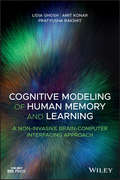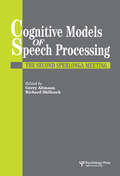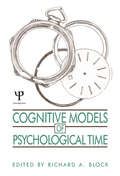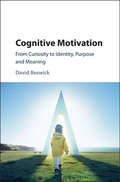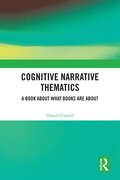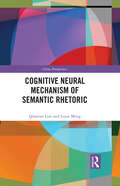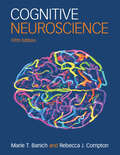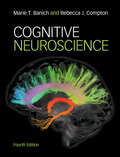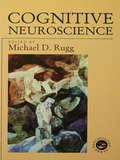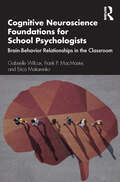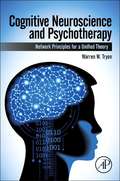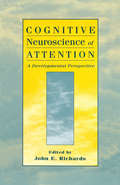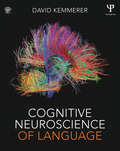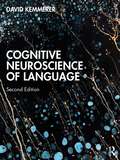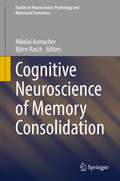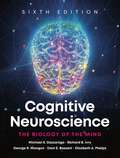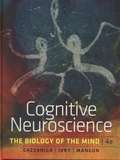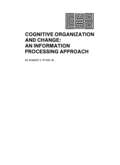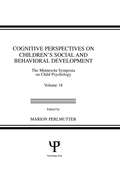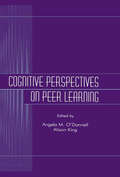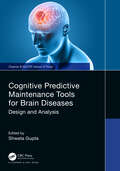- Table View
- List View
Cognitive Modeling of Human Memory and Learning: A Non-invasive Brain-Computer Interfacing Approach (Wiley - IEEE)
by Amit Konar Pratyusha Rakshit Lidia GhoshProposes computational models of human memory and learning using a brain-computer interfacing (BCI) approach Human memory modeling is important from two perspectives. First, the precise fitting of the model to an individual's short-term or working memory may help in predicting memory performance of the subject in future. Second, memory models provide a biological insight to the encoding and recall mechanisms undertaken by the neurons present in active brain lobes, participating in the memorization process. This book models human memory from a cognitive standpoint by utilizing brain activations acquired from the cortex by electroencephalographic (EEG) and functional near-infrared-spectroscopic (f-NIRs) means. Cognitive Modeling of Human Memory and Learning A Non-invasive Brain-Computer Interfacing Approach begins with an overview of the early models of memory. The authors then propose a simplistic model of Working Memory (WM) built with fuzzy Hebbian learning. A second perspective of memory models is concerned with Short-Term Memory (STM)-modeling in the context of 2-dimensional object-shape reconstruction from visually examined memorized instances. A third model assesses the subjective motor learning skill in driving from erroneous motor actions. Other models introduce a novel strategy of designing a two-layered deep Long Short-Term Memory (LSTM) classifier network and also deal with cognitive load assessment in motor learning tasks associated with driving. The book ends with concluding remarks based on principles and experimental results acquired in previous chapters. Examines the scope of computational models of memory and learning with special emphasis on classification of memory tasks by deep learning-based models Proposes two algorithms of type-2 fuzzy reasoning: Interval Type-2 fuzzy reasoning (IT2FR) and General Type-2 Fuzzy Sets (GT2FS) Considers three classes of cognitive loads in the motor learning tasks for driving learners Cognitive Modeling of Human Memory and Learning A Non-invasive Brain-Computer Interfacing Approach will appeal to researchers in cognitive neuro-science and human/brain-computer interfaces. It is also beneficial to graduate students of computer science/electrical/electronic engineering.
Cognitive Models Of Speech Processing: The Second Sperlonga Meeting (Acl-mit Series In Natural Language Processing Ser.)
by Gerry T.M. Altmann Richard ShillcockA comprehensive review for those interested in the range of theoretical concerns in speech and language processing.
Cognitive Models of Psychological Time
by Richard A. BlockThis volume critically reviews cognitive models of psychological time in order to clarify and enrich what is known about the temporal aspects of cognitive processes. Concentrating on how adult humans experience, remember, and construct time, chapters survey recent work on such topics as mental representations of time, timing in movement sequences, time and timing in music, and the processing of temporal information. Also included are chapters with a broader perspective, such as the impacts of methodological choices, chronobiology and temporal experience, a comparative approach to time and order, and normal and abnormal temporal perspectives. The book makes current research and theories on the psychology of time more accessible to researchers in cognitive psychology.
Cognitive Motivation: From Curiosity to Identity, Purpose and Meaning
by David BeswickMotivation and cognition were treated as separate concepts throughout most of twentieth-century psychology. However, in recent years researchers have begun viewing the two as inextricably intertwined: not only does what we want affect how we think, but how we think affects what we want. In this innovative study, Beswick presents a new general theory of cognitive motivation, synthesizing decades of existing research in social, cognitive and personality psychology. New basic concepts are applied to a wide range of purposive behaviour. Part I of the volume reviews different forms of cognitive motivation, such as curiosity, cognitive dissonance, achievement motivation, and the search for purpose and meaning, while Part II examines the basic processes that underlie it, such as working memory, attention and emotion. The central concept is the incomplete gestalt, in which motivation is generated by a universal striving to integrate information and make sense at all levels of cognitive organization.
Cognitive Narrative Thematics: A Book About What Books Are About
by Daniel CandelCognitive Narratives Thematics proposes a new way in which narrative works organise their thematic material. It rehabilitates the study of what books are about by providing a cognitive narrative thematic model (CNT). Part I presents CNT by combining different approaches to narrative, such as evolutionary theory, semiotics, possible worlds theory, or rhetorical criticism. Part II applies CNT to a variety of well-known narratives in different modalities, such as Robert Browning’s "My Last Duchess", Julia Donaldson’s The Gruffalo, Maurice Sendak’s Where the Wild Things Are, Frank Miller’s 300, or Mike Mignola’s Hellboy. It also considers literary histories and digital humanities. Daniel Candel shows that CNT deserves greater attention and that thematics generates its own forms and adds to the aesthetic pleasure of the text. Candel illustrates that CNT improves the established interpretations of the narrative works it studies. This innovative study reveals how CNT offers readers a deeper understanding, and how readers and critics are often using CNT intuitively without being aware of it. It is an invaluable resource for students and scholars of narrative theory.
Cognitive Neural Mechanism of Semantic Rhetoric (China Perspectives)
by Qiaoyun Liao Lijun MengThis book is a necessary supplement to the theoretical exploration into semantic rhetoric, particularly a breakthrough in the study of the relationship between the source domain and target domain involved in the construction of semantic rhetorical discourse.The study focuses on rhetorical expressions constructed by means of semantic variation or deviation of concepts. Based on the holistic cognitive pragmatic model and the framework of impartment and inheritance of connotation and denotation, this book constructs a new framework, the Annotation-Denotation Relevance-Inheritance Model (ADRIM) to explain the construing of semantic rhetoric. Besides, rooted in the Index Hypothesis Theory and the research paradigm of affordance derivation in language comprehension, three ERP experiments on metaphor, irony, and pun, are conducted to demonstrate the psychological reality that people activate possible feature extraction in the process of understanding semantic rhetoric. With those sample analyses and experiments, the feasibility and operability of ADRIM are proved. The book unfolds a combined approach of speculative research and empirical research, and can provide a new methodological alternative for semantic rhetorical studies in different languages.This title will be an essential read to students and scholars of Linguistics, East Asian Studies, and social workers who are interested in Language Studies in general.
Cognitive Neurorehabilitation
by Donald T. Stuss Gordon Winocur Ian H. Robertson Donald T. Stuss Gordon WinocurThis updated new edition summarizes the latest developments in cognitive neuroscience related to rehabilitation, reviews the principles of successful interventions and synthesizes new findings about the rehabilitation of cognitive changes in a variety of populations. With greatly expanded sections on treatment and the role of imaging, it provides a comprehensive reference for those interested in the science, as well as including the most up-to-date information for the practicing clinician. It provides clear and practical guidance on cognitive rehabilitation's effectiveness, and the latest research and clinical directions.
Cognitive Neuroscience (4th Edition)
by Marie T. Banich Rebecca J. ComptonUpdated fully, this accessible and comprehensive text highlights the most important theoretical, conceptual, and methodological issues in cognitive neuroscience. Written by two experienced teachers, the consistent narrative ensures that students link concepts across chapters, and the careful selection of topics enables them to grasp the big picture without getting distracted by details. Clinical applications such as developmental disorders, brain injuries, and dementias are highlighted. In addition, analogies and examples within the text, opening case studies, and “In Focus” boxes engage students and demonstrate the relevance of the material to real-world concerns. Students are encouraged to develop the critical thinking skills that will enable them to evaluate future developments in this fast-moving field. A new chapter on Cognitive Neuroscience and Society considers how cognitive neuroscience issues relate to the law, education, and ethics, highlighting the clinical and real-world relevance. An expanded online package includes a test bank.
Cognitive Neuroscience (Studies in Cognition)
by Michael D. RuggProviding up-to-date and authoritative coverage of key topics in the new discipline of cognitive neuroscience, this book will be essential reading in cognitive psychology, neuropsychology and neurophysiology. Striking a balance between theoretical and empirical approaches to the question of how cognition is supported by the brain, it presents the major experimental methods employed by cognitive neuroscientists and covers a representative range of the subjects currently exciting interest in the field. The nine chapters of the book have been written by leading authorities in their fields. The individual chapters provide "state-of-the-art" reviews of their respective attempts to build bridges between domains of enquiry that, until quite recently, were largely independent of one another. The chapters include two describing the different methods that are now available for non-invasive measurement of human brain activity; another two that discuss various current theoretical approaches to the problem of how information is coded in the nervous system; and single contributions dealing with the neural mechanisms of long-term memory and of movement, the functional and neural architecture of working memory, the organization of language in the brain, and the relationship between perception and consciousness.Cognitive Neuroscience will appeal to advanced undergraduate and graduate students interested in the relationship between the brain and higher mental functions, as well as to established researchers in cognitive neuroscience and related fields.
Cognitive Neuroscience Foundations for School Psychologists: Brain-Behavior Relationships in the Classroom
by Gabrielle Wilcox Frank P. MacMaster Erica MakarenkoCognitive Neuroscience Foundations for School Psychologists provides a comprehensive overview of brain-behavior relationships relevant to the support of students at all ability levels. Carefully attuned to the shared language between neuroscience, psychology, and education, this book covers basic neuroanatomy, brain development in student academic performance, and general assessment and pedagogical implications and interventions in the classroom. School psychologists will be prepared to apply judicious neuroscientific findings to the initial stages of instruction through assessment and intervention, clearly linking best practices for classroom instruction, formative and summative assessment, and evidence-based intervention.
Cognitive Neuroscience and Psychotherapy: Network Principles for a Unified Theory
by Warren W. TryonCognitive Neuroscience and Psychotherapy provides a bionetwork theory unifying empirical evidence in cognitive neuroscience and psychopathology to explain how emotion, learning, and reinforcement affect personality and its extremes. The book uses the theory to explain research results in both disciplines and to predict future findings, as well as to suggest what the theory and evidence say about how we should be treating disorders for maximum effectiveness. While theoretical in nature, the book has practical applications, and takes a mathematical approach to proving its own theorems. The book is unapologetically physical in nature, describing everything we think and feel by way of physical mechanisms and reactions in the brain. This unique marrying of cognitive neuroscience and clinical psychology provides an opportunity to better understand both. Unifying theory for cognitive neuroscience and clinical psychology Describes the brain in physical terms via mechanistic processes Systematically uses the theory to explain empirical evidence in both disciplines Theory has practical applications for psychotherapy.
Cognitive Neuroscience of Attention: A Developmental Perspective
by John E. RichardsThis volume describes research and theory concerning the cognitive neuroscience of attention. Filling a key gap, it emphasizes developmental changes that occur in the brain-attention relationship in infants, children, and throughout the lifespan and reviews the literature on attention, development, and underlying neural systems in a comprehensive manner. Special features include: * a new model of the neural control of eye movements; * a developmental perspective on the burgeoning literature on the cognitive neuroscience of attention; * the integration of ideas, research, and theories across chapters within each section via summary and commentary essays; and * a summary of the most recent work in the developmental cognitive neuroscience of attention by several of the leading researchers in this field.
Cognitive Neuroscience of Language
by David KemmererLanguage is one of our most precious and uniquely human capacities, so it is not surprising that research on its neural substrates has been advancing quite rapidly in recent years. Until now, however, there has not been a single introductory textbook that focuses specifically on this topic. Cognitive Neuroscience of Language fills that gap by providing an up-to-date, wide-ranging, and pedagogically practical survey of the most important developments in the field. It guides students through all of the major areas of investigation, beginning with fundamental aspects of brain structure and function, and then proceeding to cover aphasia syndromes, the perception and production of speech, the processing of language in written and signed modalities, the meanings of words, and the formulation and comprehension of complex expressions, including grammatically inflected words, complete sentences, and entire stories. Drawing heavily on prominent theoretical models, the core chapters illustrate how such frameworks are supported, and sometimes challenged, by experiments employing diverse brain mapping techniques. Although much of the content is inherently challenging and intended primarily for graduate or upper-level undergraduate students, it requires no previous knowledge of either neuroscience or linguistics, defining technical terms and explaining important principles from both disciplines along the way.
Cognitive Neuroscience of Language
by David KemmererCognitive Neuroscience of Language provides an up-to-date, wide-ranging, and pedagogically practical survey of the most important developments in this exciting field. It guides students through all of the major areas of investigation, beginning with the fundamental aspects of brain structure and function and then following with key topics such as classic and progressive aphasia syndromes; speech perception and production; the meanings of object nouns, action verbs, and abstract words; the formulation and comprehension of complex expressions, including grammatically inflected words, complete sentences, and entire stories; and several other domains of neurolinguistic research, including reading and writing, sign language, and the bilingual brain. Drawing heavily on prominent theoretical models, the core chapters illustrate how such frameworks are supported, and sometimes challenged, by experiments employing diverse brain mapping techniques. This edition has been thoroughly updated throughout, and now includes a dedicated chapter on the neural substrates of bilingualism. Chapters have been revised to reflect the most salient developments in the field, and the book has undergone a thoughtful restructure to mirror course teaching. While the study of language can be challenging, the text has been written accessibly and requires no previous knowledge of either neuroscience or linguistics and includes definitions of technical terms and explanations of important principles from both disciplines along the way. Accompanied by online resources for students and instructors, it is an essential companion for graduate or upper-level undergraduate students.
Cognitive Neuroscience of Memory (Cambridge Fundamentals of Neuroscience in Psychology)
by Scott D. SlotnickFully updated for the second edition, this text remains a comprehensive and current treatment of the cognitive neuroscience of memory. Featuring a new chapter on group differences in long-term memory, areas covered also include cognitive neuroscience methods, human brain mechanisms underlying long-term memory success, long-term memory failure, implicit memory, working memory, memory and disease, memory in animals, and recent developments in the field. Both spatial and temporal aspects of brain processing during different types of memory are emphasized. Each chapter includes numerous pedagogical tools, including learning objectives, background information, further reading, review questions, and figures. Slotnick also explores current debates in the field and critiques of popular views, portraying the scientific process as a constantly changing, iterative, and collaborative endeavor.
Cognitive Neuroscience of Memory Consolidation (Studies in Neuroscience, Psychology and Behavioral Economics)
by Nikolai Axmacher Björn RaschThis edited volume provides an overview the state-of-the-art in the field of cognitive neuroscience of memory consolidation. In a number of sections, the editors collect contributions of leading researchers . The topical focus lies on current issues of interest such as memory consolidation including working and long-term memory. In particular, the role of sleep in relation to memory consolidation will be addressed. The target audience primarily comprises research experts in the field of cognitive neuroscience but the book may also be beneficial for graduate students.
Cognitive Neuroscience of Natural Language Use
by Roel M. WillemsWhen we think of everyday language use, the first things that come to mind include colloquial conversations, reading and writing e-mails, sending text messages or reading a book. But can we study the brain basis of language as we use it in our daily lives? As a topic of study, the cognitive neuroscience of language is far removed from these language-in-use examples. However, recent developments in research and technology have made studying the neural underpinnings of naturally occurring language much more feasible. In this book a range of international experts provide a state-of-the-art overview of current approaches to making the cognitive neuroscience of language more 'natural' and closer to language use as it occurs in real life. The chapters explore topics including discourse comprehension, the study of dialogue, literature comprehension and the insights gained from looking at natural speech in neuropsychology.
Cognitive Neuroscience: The Biology of the Mind (Sixth Edition)
by Michael S. Gazzaniga Richard B. Ivry George R. Mangun Elizabeth A. Phelps Dani S. BassettExpertise, innovation, and fresh perspectives in a dynamic active-learning experience Cognitive Neuroscience is universally recognized as the gold-standard text for undergraduate students. For the Sixth Edition, the authors, led by Michael Gazzaniga, are proud to welcome star neuroscientists Elizabeth Phelps and Dani Bassett to the author team. Phelps and Bassett are widely viewed as two of the most accomplished neuroscientists working today, and together they bring cutting-edge research and a modern perspective to this highly esteemed text. This purchase offers access to the digital ebook only.
Cognitive Neuroscience: The Biology of the Mind Fourth Edition
by Michael S. Gazzaniga Richard B. Ivry George R. MangunThe first textbook for the course, and still the market leader, Cognitive Neuroscience has been thoroughly refreshed, rethought, and reorganized to enhance students' and instructors' experience. The table of contents and the chapters themselves have been reorganized to improve the logical flow of the narrative, and the world renowned author team has kept the book fully up to date on the latest research in this fast moving field.
Cognitive Organization and Change: An Information-processing Approach (Complex Human Behavior Ser.)
by R. S. Wyer, Jr.This book grew out of a graduate course in cognitive organization and change that the author taught during his tenure at the University of Illinois at Chicago Circle. Two primary objectives of the course are reflected in this book: first, to provide a general conceptual framework for critically and systematically analyzing research and theory on attitude and opinion change; second, to stimulate research on fundamental problems, related to these phenomena, that are made salient as a result of this analysis. First published in 1974. Routledge is an imprint of Taylor & Francis, an informa company.
Cognitive Perspectives on Children's Social and Behavioral Development: The Minnesota Symposia on Child Psychology, Volume 18 (Minnesota Symposia on Child Psychology Series)
by Marion PerlmutterThis volume contains the papers presented at the eighteenth Minnesota Symposia on Child Psychology, held October 27-29, 1983, at the University of Minnesota, Minneapolis. As has been the tradition for this annual series, the faculty of the Institute of Child Development invited internationally eminent researchers to present their research and to consider problems of mutual concern to scientists studying development. The theme of the eighteenth symposium, and the present volume was cognitive perspectives on social and behavior development.
Cognitive Perspectives on Peer Learning (Rutgers Invitational Symposium on Education Series)
by Angela M. O'Donnell Alison KingThe contribution of this volume to the literature on peer learning is its focus on approaches that reflect a common concern with cognitive processes based in developmental, information processing, or more generally, constructivist perspectives on peer learning. Although the clear importance of the social context of peer learning is not ignored, the volume's emphasis is on the cognitive growth that occurs within the learning environment. Any discussion of peer learning involves consideration of who is learning, how the role of peers with whom one works can be conceptualized, what it is that peers learn together, what changes as a result of the interaction, and how we can know what occurs in groups or what has been learned. The chapters in this book speak to these questions. The key question underlying many of these others is why we should worry about the intricacies of peer interaction. Both the practical and theoretical reasons for doing so are delineated. The developmental theory presented in the Introduction lays the foundation for the later descriptions of specific techniques, though many of the techniques reflect a range of other influences as well. Part I presents the implications of the work of two major theorists in cognitive development, Piaget (Ch. 1) and Vygotsky (Ch. 2). In Part II, six chapters describe a variety of peer learning techniques or models of collaboration, many of which are influenced by the work of Piaget and Vygotsky. The chapters in Part III consider the role of the teacher and the skills needed when using peer learning as an instructional strategy. The Conclusion points to areas in which further research is needed. This volume is based on original papers presented by the contributing authors in November 1996 at the Rutgers Invitational Symposium on Education on Cognitive Skills and Learning With Peers.
Cognitive Pluralism
by Steven HorstAn argument that we understand the world through many special-purpose mental models of different content domains, and an exploration of the philosophical implications.Philosophers have traditionally assumed that the basic units of knowledge and understanding are concepts, beliefs, and argumentative inferences. In Cognitive Pluralism, Steven Horst proposes that another sort of unit—a mental model of a content domain—is the fundamental unit of understanding. He argues that understanding comes not in word-sized concepts, sentence-sized beliefs, or argument-sized reasoning but in the form of idealized models and in domain-sized chunks. He argues further that this idea of “cognitive pluralism”—the claim that we understand the world through many such models of a variety of content domains—sheds light on a number of problems in philosophy.Horst first presents the “standard view” of cognitive architecture assumed in mainstream epistemology, semantics, truth theory, and theory of reasoning. He then explains the notion of a mental model as an internal surrogate that mirrors features of its target domain, and puts it in the context of ideas in psychology, philosophy of science, artificial intelligence, and theoretical cognitive science. Finally, he argues that the cognitive pluralist view not only helps to explain puzzling disunities of knowledge but also raises doubts about the feasibility of attempts to “unify” the sciences; presents a model-based account of intuitive judgments; and contends that cognitive pluralism favors a reliabilist epistemology and a “molecularist” semantics. Horst suggests that cognitive pluralism allows us to view rival epistemological and semantic theories not as direct competitors but as complementary accounts, each an idealized model of different dimensions of evaluation.
Cognitive Predictive Maintenance Tools for Brain Diseases: Design and Analysis (Chapman & Hall/CRC Internet of Things)
by Shweta GuptaThis book involves the design, analysis, and application of various cognitive predictive maintenance tests with the help of tools like vibration analysis, ultrasonic analysis, infrared analysis, oil analysis, laser-shaft alignment, and motor circuit analysis in the prediction of various cognitive diseases such as epilepsy, Parkinson’s disease, Alzheimer’s disease, and depression. These are needed since there are no proper medical tests available to predict these diseases in remote areas at an early stage. Various emerging technologies are analyzed for the design of tests. Key features: Incorporates innovative processes for treating cognitive diseases. Early and exact identification and treatment strategies are incorporated. Future technologies like artificial intelligence, machine learning, the IoT, and data science are used to find solutions. Analysis with existing cognitive disease solutions is incorporated and simulations provided. The novelty of the book lies in the accurate prediction of cognitive diseases. Encompassing future technologies and various communication protocols or devices available for cognitive diseases for the design of new equipment are an outcome of the book. Various parameters like power consumption, productivity, and safety should be taken into account during the analysis, design, and application of a product. The book could well be added to the curriculum of medical colleges and biomedical engineering students. Possible vendors include biomedical research centers like Biotechnika and the Indian Council of Medical Research (ICMR). It would be a breakthrough for biomedical companies to launch their new products.
